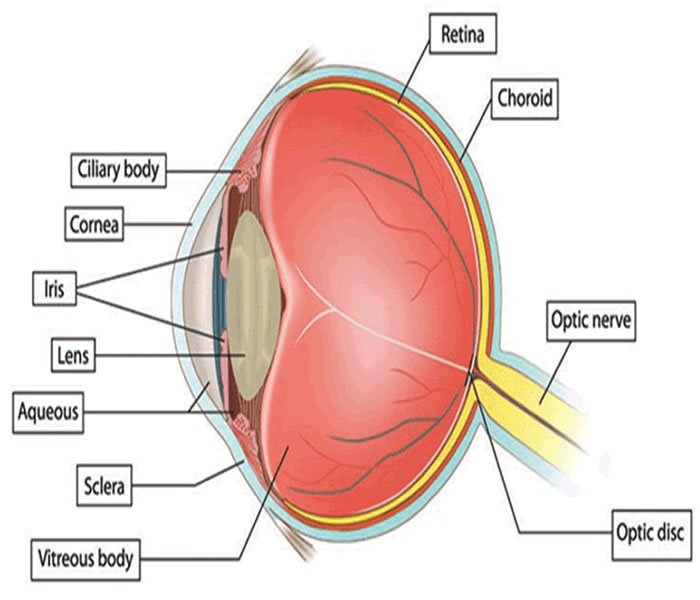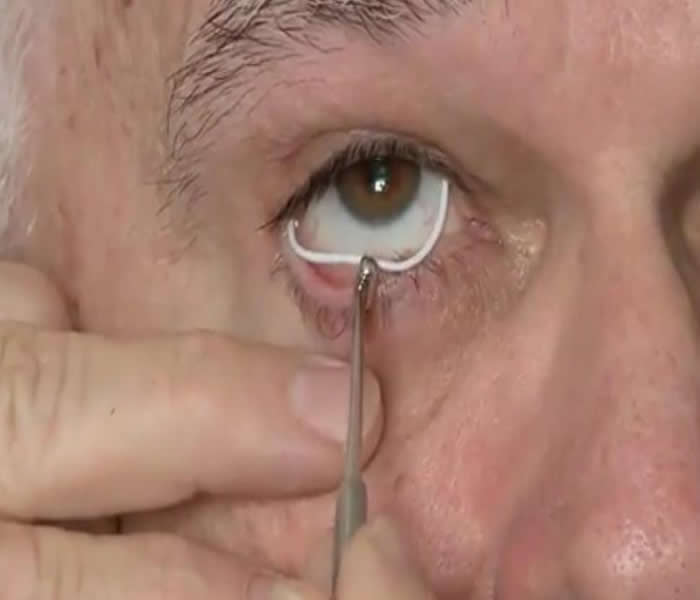Glaucoma
Is Glaucoma?
Glaucoma is known as silent thief of sight.
Glaucoma is a disease that damages your eye's optic nerve. It usually happens when fluid builds up in the front part of your eye. That extra fluid increases the pressure in your eye, damaging the optic nerve. That is it is a disease of the eye in which fluid pressure within the eye rises.

Glaucoma is a group of diseases that damage the eye’s optic nerve and can result in vision loss and blindness. However, it can be cured if with early detection and treatment, you can often protect your eyes against serious vision loss.
The increased pressure, called intraocular pressure, can damage the optic nerve, which transmits images to the brain. If damage to the optic nerve from high eye pressure continues, glaucoma will cause permanent loss of vision. Without treatment, glaucoma can cause total permanent blindness within a few years.
Glaucoma is the name given to a group of eye diseases in which the optic nerve at the back of the eye is slowly destroyed. Glaucoma is a condition of increased pressure within the eyeball, causing gradual loss of sight.
Eye Anatomy
A tough white covering called the sclera protects the eye. Part of the white sclera can be seen in the front of the eye. A clear, delicate membrane called the conjunctiva covers the sclera.
At the front of the eye is the cornea. The cornea is the clear part of the eye’s protective covering. It allows light to enter the eye. The iris is the colored part of the eye that contracts and expands so the pupil can let just the right amount of light into the eye. The light is directed by the pupil to the lens. The lens focuses the light onto the retina (lining the back of the eye). Nerve fibers in the retina carry images to the brain through the optic nerve.
Healthy Drainage
The front part of the eye is filled with a clear fluid called intraocular fluid or aqueous humor, made by the ciliary body. The fluid flows out through the pupil. It is then absorbed into the bloodstream through the eye’s drainage system.
This drainage system is a meshwork of drainage canals around the outer edge of the iris. Proper drainage helps keep eye pressure at a normal level. The production, flow, and drainage of this fluid is an active continuous process that is needed for the health of the eye.
The inner pressure of the eye (intraocular pressure or IOP) depends upon the amount of fluid in the eye. If your eye’s drainage system is working properly then fluid can drain out and prevent a buildup. Likewise, if your eye’s fluid system is working properly, then the right amount of fluid will be produced for a healthy eye. Your IOP can vary at different times of the day, but it normally stays within a range that the eye can handle.
In most types of glaucoma, the eye’s drainage system becomes clogged so the intraocular fluid cannot drain. As the fluid builds up, it causes pressure to build within the eye. High pressure damages the sensitive optic nerve and results in vision loss.
The Optic Disc
You have millions of nerve fibers that run from your retina to the optic nerve. These fibers meet at the optic disc. As fluid pressure within your eye increases, it damages these sensitive nerve fibers and they begin to die. As they die, the disc begins to hollow and develops a cupped or curved shape. If the pressure remains too high for too long, the extra pressure can damage the optic nerve and result in vision loss.
Is There Another Cause?
It was once thought that high intraocular pressure (IOP) was the main cause of this optic nerve damage. Although IOP is clearly a risk factor, we now know that other factors must be involved because people with “normal” IOP can experience vision loss from glaucoma.
The Fluid Inside
Aqueous humor is the clear, watery fluid that is continually produced inside the eye. It is different from your tears. Tears are produced by glands outside of the eye and moisten the outer surface of the eyeball.
By glaucoma.org
Types of Glaucoma
- Congenital glaucoma
- Glaucoma suspect
- Normal-tension glaucoma
- Narrow-angle glaucoma
- Open-angle glaucoma
- Secondary glaucoma
Causes of Glaucoma
Glaucoma damage is due to an increased pressure inside the eye - a result of blockage of the circulation of aqueous, or its drainage.
Another cause of glaucoma is poor blood supply to the vital optic nerve fibres, a weakness in the structure of the nerve or a problem in the health of the nerve fibres themselves. Which means the main cause is a failure of the eye to maintain an appropriate balance between the amount of internal (intraocular) fluid produced and the amount that drains away
Glaucoma can often be caused by another eye condition or disease. This is known as secondary glaucoma. For example, someone who has a tumor or people undergoing long-term steroid therapy may develop secondary glaucoma. Other causes of secondary glaucoma include:
- Abnormal blood vessel formation from diabetes or retinal blood vessel blockage
- Eye injury
- Inflammation of the eye
- Use of steroid-containing medications (pills, eyedrops, sprays)
Pigment dispersion, where tiny fragments or granules from the iris (the colored part of the eye) can circulate in the aqueous humor (the fluid within the front portion of the eye) and block the trabecular meshwork, the tiny drain for the eye’s aqueous humor.
Symptoms/Signs of Glaucoma
- Blurred or hazy vision.
- Halos around lights(That look like appearance of rainbow-colored circles around bright lights)
- Nausea and vomiting
- Reddening of the eye.
- Severe eye pain.
- Sudden onset of visual disturbance, often in low light.
- Vision loss

How to diagnose Glaucoma
Glaucoma can be treated with these techniques:
- Prescription eye drops
- Laser surgery
- Microsurgery
Eye drops for glaucoma: These either reduce the formation of fluid in the front of the eye or increase its outflow. Side effects of glaucoma drops may include allergy, redness of the eyes, brief stinging, blurred vision, and irritated eyes. Some glaucoma drugs may affect the heart and lungs. Be sure to tell your doctor about any other medications you are currently taking or are allergic to.
Laser surgery for glaucoma: Laser surgery for glaucoma slightly increases the outflow of the fluid from the eye in open-angle glaucoma or eliminates fluid blockage in angle-closure glaucoma. Types of laser surgery for glaucoma include trabeculoplasty, in which a laser is used to pull open the trabecular meshwork drainage area; iridotomy, in which a tiny hole is made in the iris, allowing the fluid to flow more freely; and cyclophotocoagulation, in which a laser beam treats areas of the middle layer of the eye, reducing the production of fluid.
Microsurgery for glaucoma: In an operation called a trabeculectomy, a new channel is created to drain the fluid, thereby reducing intraocular pressure that causes glaucoma. Sometimes this form of glaucoma surgery fails and must be redone. For some patients, a glaucoma implant is the best option. Other complications of microsurgery for glaucoma include some temporary or permanent loss of vision, as well as bleeding or infection.

Who is at risk?
People with more risk of developing glaucoma include people who:
- Are over age 40
- Are of African or Hispanic heritage
- Are farsighted or nearsighted
- Are of Asian heritage
- Have high eye pressure
- Have family members with glaucoma
- Have had an eye injury
- Have corneas that are thin in the center or
- Have diabetes, migraines, high blood pressure, poor blood circulation or other health problems affecting the whole body.
How to Prevent Glaucoma
Timely diagnosis and appropriate treatment are keys to glaucoma prevention
If you notice that the way you are seen long or short distance is reducing, go for eye test for early detection.
That’s a pretty close analogy of what happens when glaucoma runs its course. You’ll start losing your peripheral vision first, one eye at a time, and you likely won’t even realize that it’s happening until much of the damage has been done. The damage is irreversible! But the process can be stopped with early detection and treatment.
Treatment for Glaucoma
- Take these into consideration
- Avoid use of caffeine. Drinking beverages with large amounts of caffeine may increase your eye pressure.
- Take water regularly: Drink only moderate amounts of fluids at any given time during the course of a day.
- Sleep with your head elevated. Using a wedge pillow that keeps your head slightly raised, about 20 degrees, has been shown to reduce intraocular eye pressure while you sleep.
- Take prescribed medicine. Using your eyedrops or other medications as prescribed can help you get the best possible result from your treatment. Be sure to use the drops exactly as prescribed. Otherwise, your optic nerve damage could get even worse.
- Contact lenses
- Eye drops
- Laser surgery
- Pills
- Traditional surgery or a combination of these methods
Contact lenses
If you usually wear contact lenses and have been prescribed eye drops, you may need to stop wearing your lenses and wear glasses instead.
This is because medication in the eye drops can build up in the lenses and may harm your eyes. You should discuss this with healthcare professionals treating you.
Glaucoma Home Remedies/Home Cure
Vitamin C supplementation is safer and far more effective than traditional drug treatment for glaucoma. At 1,500 mg daily, using this vitamin has led to almost-normal eye pressure levels. In an acute situation, Vitamin C can be given intravenously to affect a greater initial pressure reduction.
The goal of any treatment is to prevent loss of vision, as vision loss from glaucoma is irreversible.
Complications of Glaucoma
- Elevated IOP
- Hyphema
- Severe pain
- If left untreated the patient may lose vision, and even become blind.




